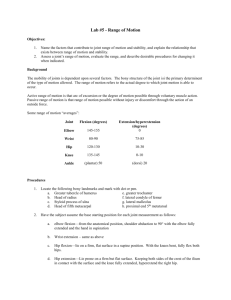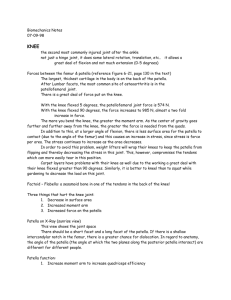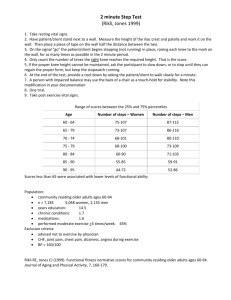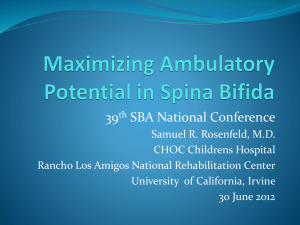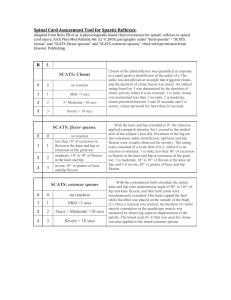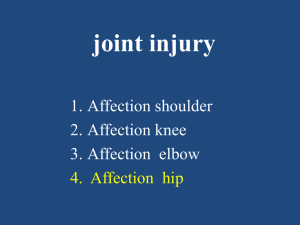(Ankle, Knee and Hip) - Academic Day
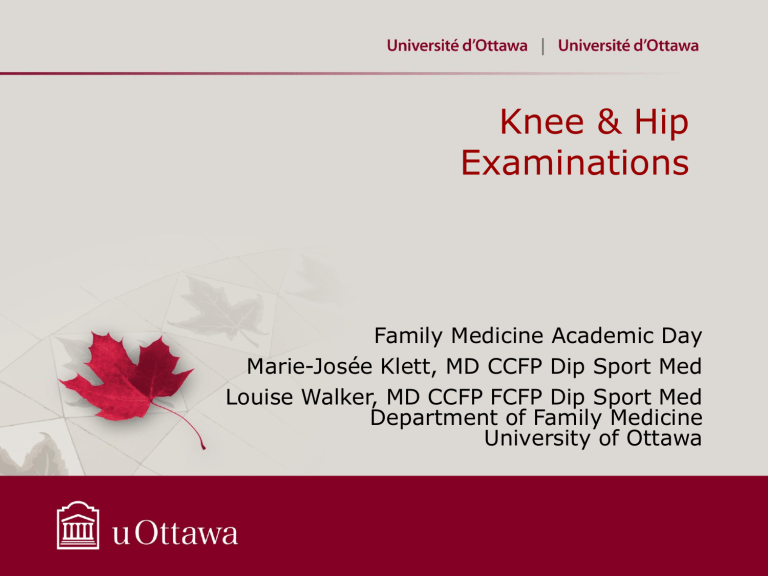
Knee & Hip
Examinations
Family Medicine Academic Day
Marie-Josée Klett, MD CCFP Dip Sport Med
Louise Walker, MD CCFP FCFP Dip Sport Med
Department of Family Medicine
University of Ottawa
Confidentiality and Conflict Declaration
Speakers have no conflicts of interest to declare
This presentation and associated handouts are for use by University of Ottawa DFM residents and are not to be used for other purposes or distributed without the written consent from the speakers
Knee History
• Role play
Knee History
Nature of the problem – pain, swelling, catching/locking, giving way
Duration
Mechanism of injury
Location of pain
Radiation of the pain
Aggravating factors
Relieving factors
Pain during and/or after activity
Rx to date; Past Hx; ROS; FHx; Meds;
Allergies;
“Other”-reason for visit at this time; sporting history; legal
LOOK
Standing :
Alignment
Knee: Normal, Recurvatum, Holds in Flexion
Varus (finger distance between knees)
Valgus (intermalleolar distance)
Deformity
Visible swelling front or popliteal space
Feet: Pes planus, Pes cavus, Overpronation
Alignment
Feet
Overpronation
Baker’s cyst
LOOK
Walking :
Gait: Antalgic favours: Right or Left
Varus thrust
PWB NWB
AIDS: crutches/cane/w/c
LOOK
Sitting
Skin -
Redness/Blueness/Mottled/Abrasions/Scar/E cchymosis
Muscle – contract quads- Lateral Tracking
(“J” Sign)
Tibia: Internal Rotation
External Rotation
FEEL
Palpate Point(s) of Maximal Tenderness:
Bones: joint lines (knee bent), femoral condyles
(knee bent), patellar facets, tibial plateau/tubercle, fibula
Ligaments: MCL, LCL
Tendons: Patellar, Quad, Hamstring, ITB, Pes
Anserine
Can also feel soft tissue swelling and muscle bulk (atrophy)
Surface Anatomy: Practice
Pes Anserine
MOVE
Range of Motion: Active, Passive, Resisted
Extension
Flexion
Feel for Crepitus (retropatellar during active flexion/extension)
Hip screen: at least passive Flex + IR + ER
(Ext/Abd/Add if abnormal)
Special Tests
• Meniscus
• Ligaments
• Patella
Meniscus: Anatomy
Meniscus: History
• Usually specific incident: most often twisting injury
• Often associated with swelling, can have catching and/or locking
• Pain with squatting, kneeling, twisting
• Medial or lateral pain but sometimes difficult to localise
Meniscus: Physical Exam
• Often have small to medium effusion: bulge test
• http://www.youtube.com/watch?v=LsgutijmX7
U
• Pain with passive flexion OR 2.3
• Joint line tenderness Sens 76% Spec 29%
Meniscus: Physical Exam
• McMurray: externally rotate and abduct for medial, internally rotate and adduct for lateral, click with pain is positive.(Sens 52% Spec
97%)
• Thessaly: twist on affected knee with 20 o of flexion, pain is positive. (Sens 96% Spec
95%)
• Apley Grind: patient prone, apply load to knee and grind, pain is positive. (Very little data)
Meniscus: Thessaly
Practice
• Passive flexion and extension
• Bulge test
• McMurray’s
• Thessaly’s
Ligaments: Anatomy
MCL: Anatomy
ACL: Anatomy
Ligaments: History
• Mechanism of injury:
– Collaterals: valgus or varus force
– ACL: plant and twist, hyperextension or quick deceleration
– PCL: direct anterior force on bent knee
(dashboard injury or fall onto tibia of flexed knee)
• May have heard/felt a pop
• ACL: immediate large swelling
• Feeling of instability
MCL/LCL: Physical Exam
• LOOK – soft-tissue swelling
• FEEL - tenderness over ligament
• TEST- at 0 and 20 degrees-test for pain and laxity to differentiate grade of injury
PCL: Physical Exam
• Mild to moderate effusion
• May not have any palpable tenderness but can feel step-off
• Posterior Sag/Posterior drawer test
PCL: Posterior Sag
PCL: Posterior Drawer
ACL Physical Exam:
• Hemarthrosis: large effusion (patellar tap)
• May have associated meniscal or MCL tear
• Can have avulsion fracture lateral tibial plateau so tenderness there common
• Lachman (15-30 o flexion) most sensitive and specific knee test, Anterior Drawer, Pivot Shift (if MCL intact and no meniscus tear)
Anterior drawer: Sens 48% Spec 87%
Pivot shift: Sens 61% Spec 97% (but only studied by its developers)
Lachman’s: Sens 87% Spec 93%, LR+ 42.0
ACL: Lachman’s
Practice
• Lachman’s (or Drop Leg Lachman’s)
• MCL & LCL Collateral tests (at 0 and 20)
• Posterior Drawer
Patella: Anatomy
Patella: History
• Anterior knee pain
• Often worse going down stairs, squatting, kneeling
• Sometimes pain will cause quads inhibitionpatients get giving way
Patella: Physical Exam
• Look for contributing biomechanical factors: genu valgus, femoral anteversion, pes planus/overpronation
• Tender patella facettes, retropatellar crepitus
• J-sign
• Assess patella: Laxity/apprehension, compression/Osmond-Clark
• Assess for correctable factors:
– Tightness: hamstrings, IT Band (Ober’s)
– Strength: VMO, abductors
Patella: Obers
Practice
• Palpation of patellar facets
• J-sign
• Laxity/apprehension
• Compression test
• Ober’s
• Hip Abductor strength
HIP ASSESSMENT
HISTORY
Chief Complaint:
Mechanism of injury:
Duration:
Location:
Radiation:
Other
Lateral
Groin
Severity when most severe: (0 to 10)
Anterior Other “C” SIGN
Buttocks Thigh
Catching:
When does pain occur? (rest; sitting; walk; run; stairs up/down; uneven ground; in/out car; during activity; after activity; morning; afternoon; night; other relation to bowel bladder, menses):
Relieving Factors:
Treatment to date:
Past history of knee injury or related hx:
Other medical history:
Medication:
Allergies:
Hip: Location of Pain
HIP: PHYSICAL EXAMINATION
LOOK
FEEL
MOVE
SPECIAL TESTS
LOOK
Standing : Alignment
Walking : Antalgic favours: Right Left
Trendelenburg
PWB NWB
AIDS: crutches/cane/w/c
LOOK
Lying:
Swelling
Muscle wasting
Flexion deformity
Position
FEEL
Palpate points of maximal tenderness:
Bones: ASIS, Greater trochanter and bursa, Pubic ramus and symphysis, Ischial tuberosity, SI joints
Muscles & Tendons: Adductors, IT band (TFL), gluteus minimus/maximus, piriformis, Hamstring
Abdomen and Lumbar Spine if indicated
Hip bones
Hip Muscles
“Glutes” and GT Bursae
Piriformis
Glut Minimus
Glut Medius
GT Bursa of Glut Maximus
Glut Maximus
GT Bursa of Glut Medius
Practice
• Bones:
– Greater trochanter
– Pubic Symphysis
– Anterior Inferior and Superior Iliac Spine
– Ischial tuberosity
– SI joints
• Muscles:
– Piriformis
MOVE
Hip Range of Motion:
Active Passive
Flexion: (~120 ° )
Extension: (~20-30 ° )
Abduction: (~45-50 ° )
Adduction: (~20 ° )
Internal rotation: (~35 ° )
External rotation: (~45 ° )
Resisted
Special Tests
FAI or FADDIR testing: labrum/joint
Trendelenburg test: abductor strength
Thomas test (flexion contracture/ITB tightness)
FABER: Pain (groin, lateral, SI)
Functional tests: Hop on Rt and Lt (pain?)
Flexion-adduction-internal rotation test (FAI)
Trendelenburg test
Thomas test
FABER
Back: Special Tests
• Back ROM:
Flexion Extension Lateral flexion
• Sacro-iliac Kinetic Test
• Leg Lengths: Rt_____cm.
Lt_____cm.
Rotation
Practice
Passive IR
FAI test
Trendelenburg test
Thomas test
FABER

